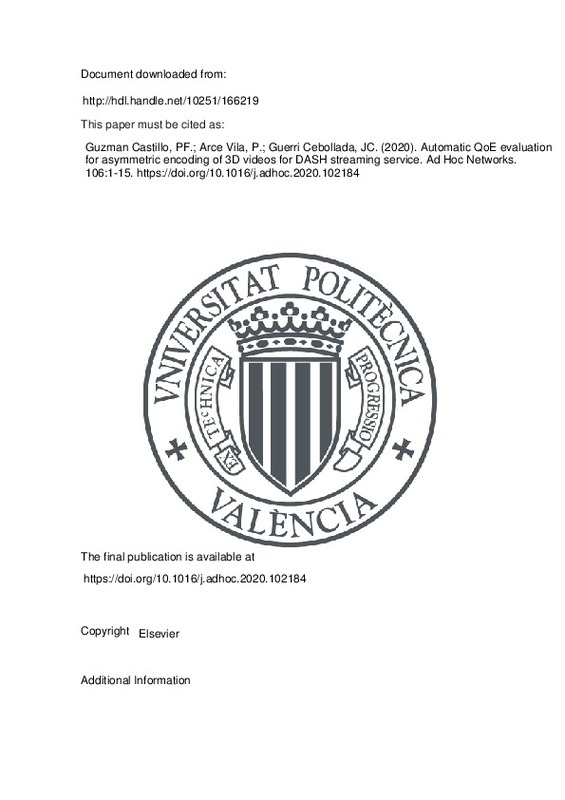Cisco, “Cisco Visual Networking Index : forecast and Trends, 2017–2022 White Paper.” 2019.
ISO/IEC, “ISO/IEC 23009-1 Information technology — Dynamic adaptive streaming over HTTP (DASH) — Part 1: media presentation description and segment formats Technologies, 2019,” 2019.
T. Su, A. Javadtalab, A. Yassine, and S. Shirmohammadi, “A DASH-based 3D multi-view video rate control system A DASH-Based 3D Multi-view Video Rate Control System,” 2014.
[+]
Cisco, “Cisco Visual Networking Index : forecast and Trends, 2017–2022 White Paper.” 2019.
ISO/IEC, “ISO/IEC 23009-1 Information technology — Dynamic adaptive streaming over HTTP (DASH) — Part 1: media presentation description and segment formats Technologies, 2019,” 2019.
T. Su, A. Javadtalab, A. Yassine, and S. Shirmohammadi, “A DASH-based 3D multi-view video rate control system A DASH-Based 3D Multi-view Video Rate Control System,” 2014.
Hoßfeld, T., Seufert, M., Sieber, C., Zinner, T., & Tran-Gia, P. (2015). Identifying QoE optimal adaptation of HTTP adaptive streaming based on subjective studies. Computer Networks, 81, 320-332. doi:10.1016/j.comnet.2015.02.015
Barman, N., & Martini, M. G. (2019). QoE Modeling for HTTP Adaptive Video Streaming–A Survey and Open Challenges. IEEE Access, 7, 30831-30859. doi:10.1109/access.2019.2901778
“Puppeteer.” [Online]. Available: https://github.com/GoogleChrome/puppeteer. [Accessed: 01-Jul-2019].
Akar, G. B., Tekalp, A. M., Fehn, C., & Civanlar, M. R. (2007). Transport Methods in 3DTV—A Survey. IEEE Transactions on Circuits and Systems for Video Technology, 17(11), 1622-1630. doi:10.1109/tcsvt.2007.905365
Merkle, P., Müller, K., & Wiegand, T. (2010). 3D video: acquisition, coding, and display. IEEE Transactions on Consumer Electronics, 56(2), 946-950. doi:10.1109/tce.2010.5506024
Gürler, C. G., Görkemli, B., Saygili, G., & Tekalp, A. M. (2011). Flexible Transport of 3-D Video Over Networks. Proceedings of the IEEE, 99(4), 694-707. doi:10.1109/jproc.2010.2100010
Vetro, A., Wiegand, T., & Sullivan, G. J. (2011). Overview of the Stereo and Multiview Video Coding Extensions of the H.264/MPEG-4 AVC Standard. Proceedings of the IEEE, 99(4), 626-642. doi:10.1109/jproc.2010.2098830
Hannuksela, M. M., Gabbouj, M., Rusanovskyy, D., Su, W., Chen, L., Li, R., … Li, H. (2013). Multiview-Video-Plus-Depth Coding Based on the Advanced Video Coding Standard. IEEE Transactions on Image Processing, 22(9), 3449-3458. doi:10.1109/tip.2013.2269274
Chikkerur, S., Sundaram, V., Reisslein, M., & Karam, L. J. (2011). Objective Video Quality Assessment Methods: A Classification, Review, and Performance Comparison. IEEE Transactions on Broadcasting, 57(2), 165-182. doi:10.1109/tbc.2011.2104671
T. Wiegand and G.J. Sullivan, “The H.264/AVC Video Coding Standard,” no. August 1999, pp. 148–153, 2007.
Sullivan, G. J., Ohm, J.-R., Han, W.-J., & Wiegand, T. (2012). Overview of the High Efficiency Video Coding (HEVC) Standard. IEEE Transactions on Circuits and Systems for Video Technology, 22(12), 1649-1668. doi:10.1109/tcsvt.2012.2221191
Tech, G., Chen, Y., Muller, K., Ohm, J.-R., Vetro, A., & Wang, Y.-K. (2016). Overview of the Multiview and 3D Extensions of High Efficiency Video Coding. IEEE Transactions on Circuits and Systems for Video Technology, 26(1), 35-49. doi:10.1109/tcsvt.2015.2477935
Wang, J., Wang, S., & Wang, Z. (2017). Asymmetrically Compressed Stereoscopic 3D Videos: Quality Assessment and Rate-Distortion Performance Evaluation. IEEE Transactions on Image Processing, 26(3), 1330-1343. doi:10.1109/tip.2017.2651387
Battisti, F., Carli, M., Le Callet, P., & Paudyal, P. (2018). Toward the Assessment of Quality of Experience for Asymmetric Encoding in Immersive Media. IEEE Transactions on Broadcasting, 64(2), 392-406. doi:10.1109/tbc.2018.2828607
ITU-T, “ITU-T.P910. Subjective video quality assessment methods for multimedia applications,” 2008.
H.K. Yarnagula, S. Luhadia, S. Datta, and V. Tamarapalli, “Quality of Experience Assessment of Rate Adaptation Algorithms in DASH : an Experimental Study,” pp. 1–8, 2016.
Bentaleb, A., Taani, B., Begen, A. C., Timmerer, C., & Zimmermann, R. (2019). A Survey on Bitrate Adaptation Schemes for Streaming Media Over HTTP. IEEE Communications Surveys & Tutorials, 21(1), 562-585. doi:10.1109/comst.2018.2862938
C. Timmerer, M. Maiero, and B. Rainer, “Which Adaptation Logic ? An Objective and Subjective Performance Evaluation of HTTP-based Adaptive Media Streaming Systems.”
Seufert, M., Egger, S., Slanina, M., Zinner, T., Hobfeld, T., & Tran-Gia, P. (2015). A Survey on Quality of Experience of HTTP Adaptive Streaming. IEEE Communications Surveys & Tutorials, 17(1), 469-492. doi:10.1109/comst.2014.2360940
Chen, Y., Wu, K., & Zhang, Q. (2015). From QoS to QoE: A Tutorial on Video Quality Assessment. IEEE Communications Surveys & Tutorials, 17(2), 1126-1165. doi:10.1109/comst.2014.2363139
Wang, Z., Bovik, A. C., Sheikh, H. R., & Simoncelli, E. P. (2004). Image Quality Assessment: From Error Visibility to Structural Similarity. IEEE Transactions on Image Processing, 13(4), 600-612. doi:10.1109/tip.2003.819861
Z.L. Li and A. Aaron, “Toward A Practical Perceptual Video Quality Metric,” Netflix TechBlog.
ITU-T, “ITU-T. P915. Subjective assessment methods for 3D video quality,” 2016.
ITU Telecommunication Standardization Sector, “ITU-T Rec P 1203 Models and tools for quality assessment of streamed media,” 2017.
R. I.-T. J.247, “Objective perceptual multimedia video quality measurement in the presence of a full reference.,” Recomm. ITU-T J.247, 2008.
Shaka Player Demo. [Online]. Available:https://shaka-player-demo.appspot.com. [Accessed: 01-Jun-2019].
Fiedler, M., Hossfeld, T., & Tran-Gia, P. (2010). A generic quantitative relationship between quality of experience and quality of service. IEEE Network, 24(2), 36-41. doi:10.1109/mnet.2010.5430142
Big Buck Bunny. [Online]. Available: https://peach.blender.org. [Accessed: 01-May-2019].
S. Lederer, C. Müller, and C. Timmerer, “Dynamic Adaptive Streaming over HTTP Dataset,” pp. 89–94, 2012.
[-]







![[Cerrado]](/themes/UPV/images/candado.png)


